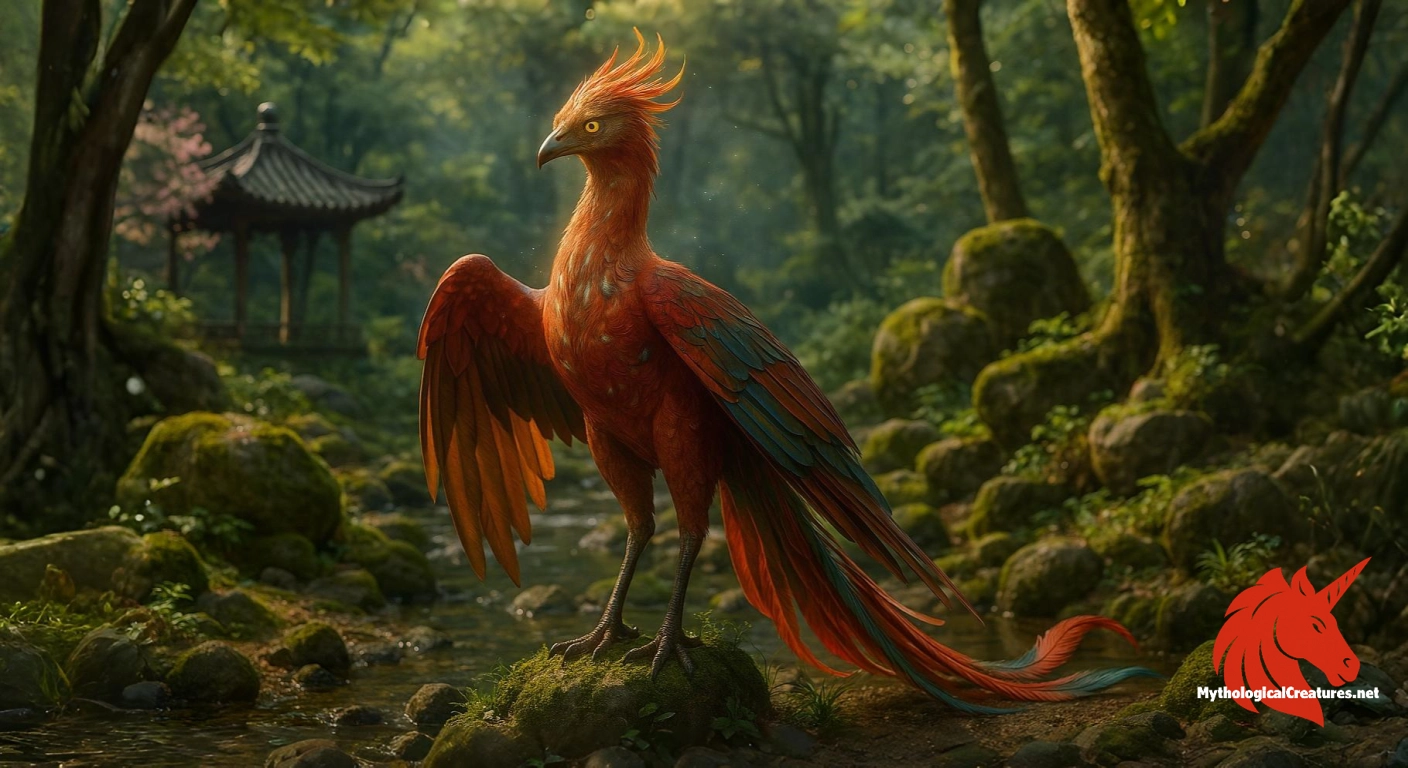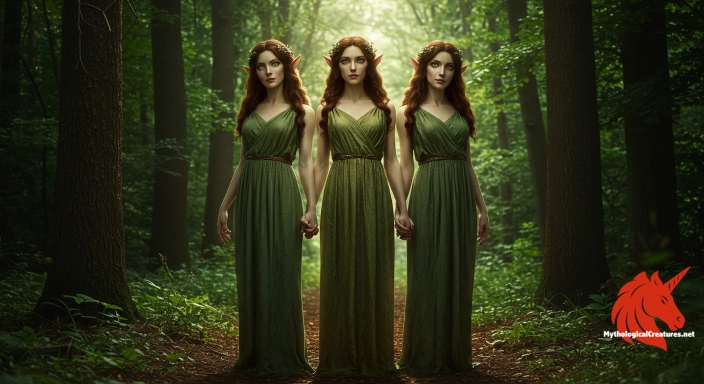Fenghuang: The Fenghuang is a revered mythological bird from Chinese traditions, symbolising grace, virtue, and the feminine principle in cosmic balance.

Fenghuang
Fenghuang - Symbolises the union of yin and yang, imperial elegance, and auspicious renewal in Chinese cultural heritage.
Origins & First Encounters
The Fenghuang is a vibrant symbol of beauty and higher virtue celebrated throughout East Asian lore. Its emergence in ancient Chinese traditions marks a significant presence in imperial courts and cultural narratives. Early accounts differentiate between the male feng and the female huang, reflecting a spirit of duality later harmonised into a singular, predominantly feminine icon. This mythical bird embodies the elegance and balance that guided the imperial ideal and served as a metaphor for cosmic order. It is revered not only for its dazzling appearance but also for its moral and auspicious connotations. The creature has long symbolised the ideal union of heaven and earth, bringing hope for prosperity and peace. Its portrayal in historical art and literature reinforces a deep connection to the natural world and the cycles of renewal. Beyond China, the Fenghuang finds interpretations in Japan, Korea, and Vietnam, each adapting its symbolism to local cultural contexts. Its enduring legacy is intertwined with the ideals of beauty, power, and harmonious existence.
Source Texts & Tale Variants
Ancient Chinese texts and imperial records have preserved numerous accounts of the Fenghuang, blending myth with historical reverence. Detailed descriptions appear in classical literature and art from the Tang and Song dynasties, where the bird is depicted as an emblem of celestial favour. Numerous folktales elaborate on the bird’s role in signalling moments of renewal and auspicious change. Narrative variants in literary circles reflect its multifaceted symbolism, ranging from themes of rebirth to divine retribution. Japanese chronicles refer to similar mythic birds known as hô-ô, illustrating the cultural exchange that enriched the creature’s lore. Korean and Vietnamese traditions further enrich its narrative through local songs, poems, and visual arts where the bird's image evolves with regional design elements. These texts, though varying in detail, consistently present the Fenghuang as a harbinger of fortune and balance. Story variants often merge elements of the natural and the divine, ensuring its longevity as a symbol of hope. The array of historical sources underscores the deep imprint this creature has left on the collective memory of the Sinosphere.
Form & Powers
The physical depiction of the Fenghuang is a study in resplendent detail and mythical elegance. Its plumage is described in vivid hues of red, gold, blue, and green, each feather shimmeringly intricate and emblematic of the cycles of nature. The bird’s head is adorned with a sweeping crest, radiating an otherworldly luminescence that complements its expressive, knowing eyes. A gracefully arching neck leads to a body that is both powerful and delicately sculpted, merging the traits of earthly birds with celestial design. The expansive wings are detailed with fine feathering that symbolises both strength and fragility. Artists have often portrayed the tail as a long, flowing cascade of feathers that fan out like a luminous banner, capturing the imagination with its dynamism. Subtle hints of dragon-like or even feline features add layers of symbolism and intrigue to the creature’s form. Variations in size and sculptural nuance across artworks suggest that the Fenghuang embodies an ideal rather than a fixed zoological form. Its overall aesthetics remain a perfect blend of natural beauty and symbolic grandeur, cultivated through centuries of artistic refinement.
Regional Faces
Distinct regional interpretations of the Fenghuang offer a rich mosaic of cultural expression within the broader Sinosphere. Chinese traditions often cast the mythic bird as a cornerstone of imperial iconography, closely tied to the dynastic cycle and celestial mandate. In Japan, the creature known as hô-ô is celebrated as a refined emblem of grace that graces traditional art and ceremonial motifs. Korean depictions as bonghwang integrate local symbolism and artistic styles that emphasise harmony with nature and collective well-being. Vietnamese imagery of the phượng hoàng is vibrant and colourful, reflecting the region’s festive spirit and deep ties to ancestral heritage. Local variations highlight subtle aesthetic nuances, from differences in feather patterns to the integration of indigenous mythic elements. In every region, the symbolism of rebirth, balance, and hopeful providence remains a central theme. Festivals and cultural rituals across these traditions often incorporate the bird’s imagery, reinforcing its role as a bearer of good fortune. Despite these regional adaptations, the enduring qualities of wisdom, strength, and grace unify the myriad portrayals of the Fenghuang.
Cultural Parallels
The Fenghuang invites a fascinating comparison with mythological birds from various global traditions, each resonating with themes of renewal and transcendence. While Western culture offers the phoenix—a firebird that rises from its ashes—as a counterpart, the Fenghuang encapsulates a more expansive array of virtues including benevolence and cosmic balance. Both creatures are symbols of cyclic regeneration, yet the Fenghuang is deeply interwoven with notions of harmonious duality. Its pairing with the Chinese dragon draws a distinctive yin-yang dynamic that sets it apart from other phoenix-like myths. Parallels are also seen in the symbolism of India’s Garuda or even revered avian figures in Native American lore, each embodying aspects of power and divine protection. The intermingling of natural beauty and spiritual significance in these myths underscores common human fascinations across cultures. Such comparative narratives reveal how similar images are reinterpreted to reflect regional values and cosmologies. The luminous artistry found in depictions of these birds creates a shared language of myth that transcends geographical boundaries. This cultural crossover enriches the dialogue between ancient traditions and contemporary interpretations of mythic imagery.
Legacy & Modern Evolution
The depiction of the Fenghuang has journeyed through centuries of cultural transformation, continually adapting to the evolving artistic and social landscape. In its earliest portrayals, the creature was integrally linked with imperial majesty, serving as a potent symbol of civilized order and moral rectitude. Over time, as societal values evolved, the Fenghuang assumed additional layers of meaning that resonated with the aspirations of common folk and artistic circles alike. Modern reinterpretations have seen the creature emerge as an emblem of resilience, hope, and the enduring beauty of nature. Contemporary art, literature, and media frequently invoke its graceful imagery to suggest continuity between past and present. Digital depictions and modern festivals have revitalised its image, blending ancient tradition with innovative visual culture. The Fenghuang continues to serve as an inspirational motif in fashion, design, and cultural celebrations, bridging the gap between myth and modern symbolic expression. This evolution highlights a persistent reverence for nature and an acknowledgment of the cyclical nature of life. Today, the creature stands as a timeless ambassador of harmony and renewal in an ever-changing world.
Interesting Fact
Although often compared to the Western phoenix, the Fenghuang is uniquely rooted in Chinese cultural values, symbolising not just rebirth, but also the harmonious balance between feminine grace and cosmic order.
Quick Creature Info
Associations:
Our Mythic Legendary Rating:

Also Sometimes Known As:
Habitat:
Supernatural Powers:
Physical Attributes:
Abilities:
Behavior:
Lore:
References
Discover Another Mythical Legend You May Not Have Heard Of?
Uncover the mysteries of ancient folklore and expand your knowledge of legendary beings from cultures around the world.
Dare to Meet the Silvanae....
Mythical Disclaimer: The images and data on this site are derived from various historical and literary sources, but we have found that many myths often have multiple versions and interpretations across references, sometimes contradictory. As a result, these creature depictions are artistic interpretations—imaginative blends of folklore, legend, and a dash of AI guesswork. Because creature descriptions vary widely, our illustrations and accompanying information represent our best effort to honor mythology while bridging creative gaps. Enjoy these interpretations—just remember, we've done our best to respect the stories and validate available data, but in the realm of mythology, details often shift, imagination leads the way, and nothing is ever set in stone!
Curated by the Mythological Creatures Team (rev. May 2025)
